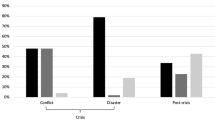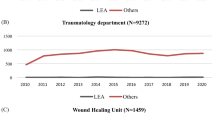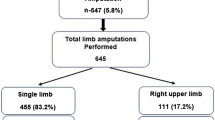Abstract
Purpose
We aimed to determine the epidemiological pattern and highlight challenges of managing traumatic amputation in our environment.
Method
This was a ten-year retrospective study of all the patients with traumatic extremity amputation seen in Ebonyi State University Teaching Hospital and Federal Medical Centre Abakaliki from January 2001 to December 2010.
Result
There were 53 patients with 58 amputations studied. There was a male to female ratio of 3:1 and the mean age was 32.67 ± 1.54 years. Amputations were more prevalent in the rainy season. Road traffic accident was the predominant causative factor and accounted for about 57% of amputations. A majority of the patients (81.4%) had no pre-hospital care and none of the amputated parts received optimum care. Three patients underwent re-attachment of amputated fingers and one was successful. Wound infection (in 56.6% of patients) was the most common complication observed. Overall mortality was 7.5% and all were due to complications of amputations.
Conclusion
Appropriate injury prevention mechanisms based on the observed patterns are needed. Educational campaigns for prevention should be intensified during the rainy season and directed toward young men. Measures aimed at improving pre-hospital care of patients and optimum care of amputated parts is an important aspect to be considered in any developmental programme of replantation services in the sub-region.



Similar content being viewed by others

References
Akinyola AL, Ojo OD, Ogini LM (2008) Microbiology of amputation wound infection in a Nigeria setting. J Wound Care 17:202–206
Boyle D, Parke D, Larson C, Pessoa-Brandao L (2000) Nature, incidence and cause of work related amputations in Minnesota. Am J Ind Med 37:542–550
Chalaya PL, Nabula JB, Ngayomela IH, Kanumba ES, Chandika AB, et al. Motorcycle injuries as an emerging public health problem in Mwanza city north-western Tanzania. http://ajol.info/index.php/thrb/article/view/55500/45811. Accessed 3 November 2010
Dillingham TR, Pezzin LE, Mackenzie EJ (1998) Incidence, acute care length of stay and discharge to rehabilitation of traumatic amputee patients: an epidemiological study. Arch Phy Med Rehabil 79:279–287
Dogan A, Sungar I, Bilgic S, Uslu M, Atik B et al (2008) Amputation in eastern Turkey (Van): a multicenter epidemiological study. Acta Orthop Traumatol Turc 42(1):53–58
Hull JB (1992) Traumatic amputation by explosives blast, pattern of injury in survivors. Br J Surg 79(12):1303–1306
Jing L, Zeng G, Qingsheng Z, Wei L, Tisheng H et al (2008) Finger replantation: determinants of survival. Plast Reconstr Surg 22(3):833–839
Kobrayashi L, Inaba K, Barmparas G, Criscuoli M, Lustenberger T et al (2010) Traumatic limb amputation at a level 1 trauma center. Eur J Trauma Emerg Surg. doi:10:1007/500068-010-001-0011-3
Liang H-W, Chen S, Hsu J, Chang C (2004) Work-related upper limb amputation in Taiwan. Am J Ind Med 46:649–655
Lloyd MS, Teo TC, Pickford MA, Arnstan PM (2005) Preoperative management of the amputated limb. Emerg Med J 22:478–480. doi:10.1136/emj2003.008797
Macharia WM, Njeru EK, Muli-Musiime F, Nantulya V (2009) Severe road traffic injuries in Kenya, quality of care and access. Afr Health Sci 9:118–124
Nasser J, Ali B (2008) Epidemiological features of extremity traumatic amputation in Babol, north Iran. http://www.jorth.org2008/5/e14. Accessed 3 November 2010
Omoke NI, Madubueze CC (2010) Machete injuries as seen in a Nigerian teaching hospital. Injury 41(1):120–124
Raja SS (2006) Management of complex tissue injuries and replantation across the world. Injury 37:1057–1060
Randal T, Loder MD (2004) Demographics of traumatic amputation in children: implications for prevention strategies. J Bone Joint Surg Am 86:923–928
Hostetler SG, Schwartz L, Shields BJ, Xiang H, Smith GA (2005) Characteristic of paediatrics traumatic amputation treated in hospital emergency department: United States 1990–2002. Paediatrics 116(5):e667–e676
Solugberu BA, Ofegbu CKP, Nasir AA, Ogundipe OK et al (2006) Motorcycle injuries in a developing country and vulnerability of riders, passengers and pedestrians. Inj Prev 12:266–268
Souka HM (1992) Management of Gulf War casualties. Br J Surg 12(79):1307–1308
Trauturein LC, Smith DG, Rivara FP (1996) Paediatric amputation injuries: aetiology, cost, and outcome. J Trauma 41(5):831–838
Tukiaimen E, Suominem E, Asko-Seljavara S (1994) Replantation revascularization and reconstruction of both legs after amputation. J Bone Joint Surg Am 76:1712–1716
Umaru RH, Gali B, Ali N (2004) Role of inappropriate traditional splintage in limb amputation in Maiduguri, Nigeria. Annals of Afr Med 3(3):138–140
Yinusa W, Ugbeye ME (2003) Problems of amputation surgery in a developing country. Int Orthop 27(2):121–124
Acknowledgement
We thank all hospital staff who assisted in this study.
Conflict of interest
The authors declare that they have no conflict of interest.
Author information
Authors and Affiliations
Corresponding author
Rights and permissions
About this article
Cite this article
Omoke, N.I., Chukwu, C.O.O., Madubueze, C.C. et al. Traumatic extremity amputation in a Nigerian setting: patterns and challenges of care. International Orthopaedics (SICOT) 36, 613–618 (2012). https://doi.org/10.1007/s00264-011-1322-7
Received:
Accepted:
Published:
Issue Date:
DOI: https://doi.org/10.1007/s00264-011-1322-7



